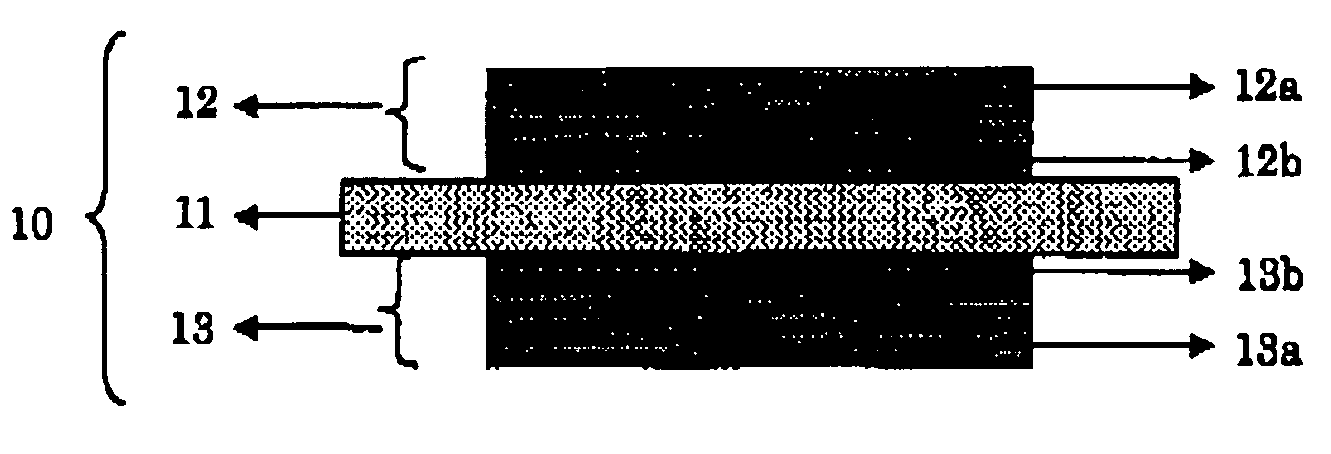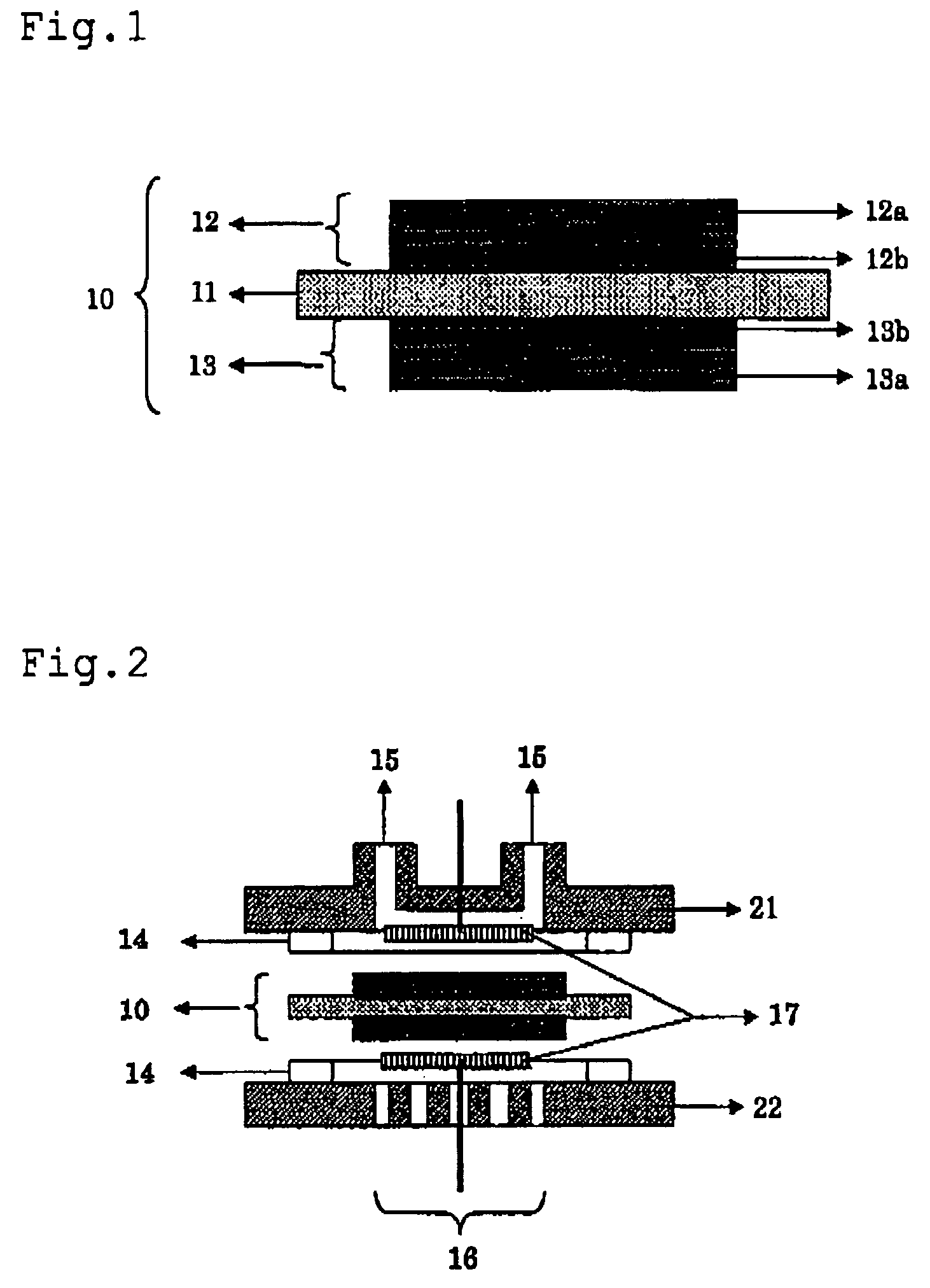Solid electrolyte, membrane and electrode assembly, and fuel cell
a solid electrolyte and electrode technology, applied in the direction of non-aqueous electrolyte cells, cell components, sustainable manufacturing/processing, etc., can solve the problems of insufficient proton conductivity, decrease in mechanical strength and solubilization in an aqueous solvent, and decrease in proton conductivity, etc., to achieve excellent ion conductivity and gas diffusivity, excellent ion conductivity
- Summary
- Abstract
- Description
- Claims
- Application Information
AI Technical Summary
Benefits of technology
Problems solved by technology
Method used
Image
Examples
example 1
Manufacture of a Solid Electrolyte
[0148] While using 2,2-bis(4-hydroxyphenyl)propane and bis(4-chlorophenylphenyl)sulfone as monomers, polysulfone was synthesized according to a general polymerization method described in “Jikken Kagaku Kouza (Experimental Chemistry Course) ver. 4, vol. 28, Kobunshi Gousei (Polymer Synthesis) p 357 (Maruzen).
Synthesis of Polysulfone
[0149] To a 500 ml 3-necked flask provided with an agitator, a nitrogen-introducing tube and a Dean-Stark trap, 2,2-bis(4-hydroxyphenyl)propane (22.8 g, 0.1 mol), bis(4-chlorophenyl)sulfone (28.7 g, 0.1 mol), potassium carbonate (17.25 g, 0.125 mol), dimethylacetamide (DMAc) (150 ml), toluene (75 ml) were charged. The mixture was refluxed for 6 hours under nitrogen atmosphere, and then surplus toluene was removed by reducing pressure. The reaction mixture was then heated at 160° C. for 10-12 hours. The resulting viscous solution was cooled to 100° C., to which chlorobenzene (75 ml) was added, followed by filtering a b...
example 2
Manufacture of Fuel Cell
[0168] (1) Manufacture of Catalyst Film
[0169] 2 g of a platinum-carrying carbon (50% by mass of platinum is carried on Vulcan XC72) and 15 g of a solution (5% DMF solution) of the polymer synthesized in Example 1 were mixed and dispersed with an ultrasonic dispersing apparatus for 30 minutes. The obtained dispersed liquid was coated on polytetrafluoroethylene film (thickness: 200 μm) and dried. The film was then punched out into a predetermined size to manufacture a catalyst film.
(2) Manufacture of MEA
[0170] To both sides of the solid electrolyte film having been not subjected to salt exchange manufactured in Example 1, the catalyst film obtained above was laminated so that the coated surface contacted with the solid electrolyte film, which was thermal compression-bonded at 190° C. and 3 MPa for 2 minutes to manufacture an MEA in sequence.
[0171] After that, in order to convert sodium sulfonate of the solid electrolyte film of the MEA into acid type sul...
example 3
Manufacture of Solid Electrolyte
[0174] Polysulfone was synthesized in the same way as in Example 1, which was then chloromethylated to give 9.3 g of chloromethylated polysulfone.
Sulfonation
[0175] In a 500 ml 3-necked flask, 4.6 g (4.1×10−2 mol) of potassium-tert-butoxide ((CH3)3COK)) and 6.1 g (3.7×10−2 mol) of sodium 2-mercaptoethane sulfonate (HS—(CH2)2—SO3Na) were charged, to which 100 ml of dewatered DMF was added. The solution was stirred at 80° C. for 10 minutes under nitrogen flow.
[0176] A solution prepared by dissolving 5 g of chloromethylated polysulfone synthesized above in 100 ml of dewatered DMF was added to the 3-necked flask containing the solution prepared above using a dropping funnel. A water-cooled tube was attached to the flask, the content of which was stirred at 80° C. for 5 hours under nitrogen flow to allow it to react. Then, heating was stopped, the flask was pulled up from an oil bath and left to cool to around room temperature. Then, the resultant was...
PUM
| Property | Measurement | Unit |
|---|---|---|
| temperature | aaaaa | aaaaa |
| temperature | aaaaa | aaaaa |
| Ri | aaaaa | aaaaa |
Abstract
Description
Claims
Application Information
 Login to View More
Login to View More - R&D
- Intellectual Property
- Life Sciences
- Materials
- Tech Scout
- Unparalleled Data Quality
- Higher Quality Content
- 60% Fewer Hallucinations
Browse by: Latest US Patents, China's latest patents, Technical Efficacy Thesaurus, Application Domain, Technology Topic, Popular Technical Reports.
© 2025 PatSnap. All rights reserved.Legal|Privacy policy|Modern Slavery Act Transparency Statement|Sitemap|About US| Contact US: help@patsnap.com



